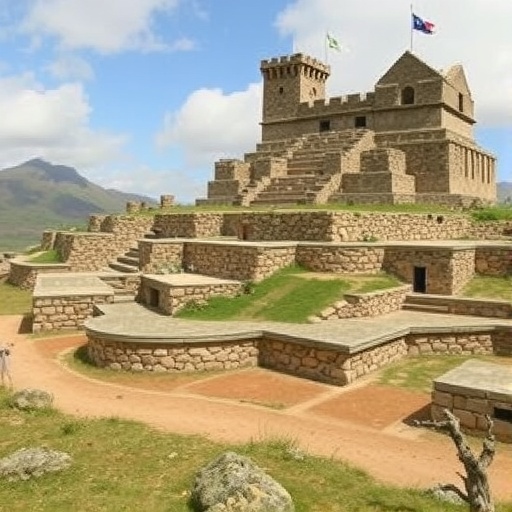Recent advancements in ancient DNA analysis have provided a remarkable insight into the demographic history of early human civilizations. A new study led by researchers including Li, J., Nie, W., and Cai, D., takes us back to the Late Neolithic age in the Eastern Nihewan basin, illuminating a complex tapestry of human migration, adaptation, and interaction during this pivotal period in history. The research, published in Archaeological and Anthropological Sciences, examines genetic markers found in ancient remains, unraveling narratives that have long been obscured by time.
The Eastern Nihewan basin, with its rich archaeological record, has been a focal point for understanding the Neolithic transitions in China. This region, characterized by its fertile plains and strategic position, served as a crossroads for various cultures. The integration of ancient DNA research into this archaeological framework is transformative, providing quantitative data that complements traditional archaeological findings. The ability to analyze genetic material from skeletal remains allows scientists to trace population dynamics, such as migration patterns and genetic mixing, in ways that were previously unattainable.
The study showcases an impressive methodology that combines cutting-edge genetic techniques with archaeological context. Using high-throughput sequencing, the researchers extracted and analyzed mitochondrial DNA from numerous specimens uncovered in the basin. This approach not only identifies lineages but also helps in understanding the demographic shifts that were influenced by environmental changes and sociopolitical factors in Neolithic societies. The application of genomic sequencing thus establishes a more nuanced understanding of how these ancient people lived, adapted, and intermingled over generations.
Demographic history is often marked by periods of expansion, contraction, and mixing of populations. The analysis conducted in this research reveals several distinct demographic events that coincided with the development of agriculture and the rise of complex societies in the Neolithic era. It’s evident that the introduction of farming led to significant changes in population structure, as groups migrated into the Eastern Nihewan basin in search of more conducive land for cultivation. By correlating this genetic data with archaeological findings, the researchers paint a vivid picture of the social fabric of ancient communities.
An intriguing aspect of the findings is the evidence of interaction between distinct groups, suggesting not only migration but also trade and cultural exchange. The genetic material reveals a blend of lineages that may indicate intermarriage and alliances between different factions. This blending of genetic heritage points to the dynamic nature of these early communities, highlighting their adaptability and resilience in the face of environmental and social challenges.
Another fascinating element of the study pertains to the impact of climate change during the Late Neolithic period. Shifts in climate likely influenced agricultural productivity and, consequently, population movements. The researchers argue that as the environment changed, so too did the demographics of the region. Genetic evidence correlating with climatic events offers a tangible connection between environmental pressures and human response, illustrating the interplay of nature and culture throughout history.
Moreover, the findings pose significant implications for our understanding of modern human populations in East Asia. The genetic legacy of these ancient communities can still be traced in contemporary individuals, allowing modern populations to glimpse their heritage. This perspective adds depth to the ongoing discussions about identity, ancestry, and the understanding of genetic diversity in human populations today.
As the field of ancient DNA research continues to evolve, it’s clear that such interdisciplinary approaches are vital. The combination of genomics, archaeology, and environmental science yields a more comprehensive framework for examining historical narratives. The ability to reconstruct demographic histories meticulously will undoubtedly lead to new questions and avenues for research, expanding our comprehension of human evolution and migration.
The impact of this research extends beyond academic circles, prompting intrigue and engagement with history among the general public. As narratives from the past are unraveled through science, there’s a growing fascination with how these ancient civilizations can inform contemporary society. This merging of stories from millennia ago with modern scientific inquiry inspires a collective curiosity about the continuum of human existence.
In conclusion, the revelations stemming from the study of ancient DNA in the Eastern Nihewan basin underscore the complex and intertwined nature of our history. The legacy of the Late Neolithic age, as presented through genetic analysis, enhances our understanding of human adaptation, migrations, and the rich tapestry of cultural exchanges. This exploration opens new dialogues about how past societies shape our present and future.
As we look ahead, the evolving landscape of ancient DNA research promises to further enlighten us about our origins. The methodological advancements and interdisciplinary collaboration seen in studies like this not only enrich historical narratives but also redefine our connection to them. It’s indeed an exciting time for the fields of archaeology and genetics, as they unlock the secrets of our ancestral past.
The legacy of the Late Neolithic age is now closer within reach, waiting to be explored and understood through the lenses of science and historical inquiry. As more findings emerge, humanity continues to engage with its past, shaping a clearer picture of who we are and where we come from.
Subject of Research: Ancient demographic history in the Late Neolithic period in the Eastern Nihewan basin.
Article Title: Ancient DNA reveals the complex demographic history of the late neolithic age in the Eastern Nihewan basin.
Article References:
Li, J., Nie, W., Cai, D. et al. Ancient DNA reveals the complex demographic history of the late neolithic age in the Eastern Nihewan basin.
Archaeol Anthropol Sci 17, 203 (2025). https://doi.org/10.1007/s12520-025-02323-2
Image Credits: AI Generated
DOI: https://doi.org/10.1007/s12520-025-02323-2
Keywords: Ancient DNA, Neolithic, demographic history, Eastern Nihewan basin, genetic analysis.




